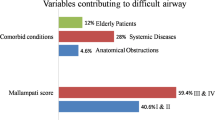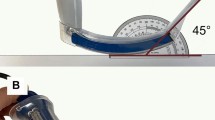Abstract
Purpose
Thyroid cancer, laryngeal cancer and retrosternal goiter are common diseases of head and neck, which often causes difficulty breathing and dyspnea. However, it is usually hard to use conventional methods to deal with this problem. The purpose of this study was to evaluate the safety and effectiveness of an interventional technique for difficult endotracheal intubation (DEI) caused by head and neck diseases.
Methods
We retrospectively analyzed the clinical data of 35 patients who underwent an interventional technique for difficult endotracheal intubation and evaluated the efficacy of this approach and observe postoperative pulse oxygen saturation (SpO2), Hugh–Jones grade, and complications.
Results
The procedures were successfully completed in all patients who underwent DEI. The technical and clinical success rate of the procedures was 100%. The average procedure duration was 3.2 ± 1.1 min (range 1–5 min). The patients’ postoperative SpO2 and Hugh–Jones grade improved, and dyspnea symptoms resolved. There were no serious EI-related complications.
Conclusions
Interventional EI under fluoroscopy is a safe, simple, and fast method for accurate intubation and an effective method for DEI; furthermore, it allows for subsequent clinical treatment.




Similar content being viewed by others
Availability of data and materials
The data sets used or analysed during the current study is available from the corresponding author on reasonable request.
References
Szarpak L (2018) Laryngoscopes for difficult airway scenarios: a comparison of the available devices. Expert Rev Med Devices 15:631–643. https://doi.org/10.1080/17434440.2018.1511423
Khan MN, Rabbani MZ, Qureshi R, Zubair M, Zafar MJ (2010) The predictors of difficult tracheal intubations in patients undergoing thyroid surgery for euthyroid goitre. J Pak Med Assoc 60:736–738
Anil AB, Anil M, Durak F et al (2021) Comparison of direct and video laryngoscope endotracheal intubations by pediatric residents: a study of a child model with normal airway. Turk Arch Pediatr 56:224–229. https://doi.org/10.5152/TurkArchPediatr.2021.20074
Chung MY, Park B, Seo J, Kim CJ (2018) Successful airway management with combined use of McGrath® MAC video laryngoscope and fiberoptic bronchoscope in a severe obese patient with huge goiter—a case report. Korean J Anesthesiol 71:232–236. https://doi.org/10.4097/kja.d.18.27203
Wu G, Li YD, Han XW, Zhang W, Han XP, Ding PX (2011) Sheath-assisted tracheal intubation: a further treatment option for patients with acute dyspnea or asphyxia caused by severe stenosis of the larynx or trachea. Ann Thorac Surg 92:710–713. https://doi.org/10.1016/j.athoracsur.2011.03.004
Komasawa N, Ueki R, Tatara T, Kaminoh Y, Tashiro C (2010) Difficult airway management using the Pentax-AWS (Airway Scope) for a patient with bilateral giant thyroid tumors. J Anesth 24:494–495. https://doi.org/10.1007/s00540-010-0901-x
Lapinsky SE (2015) Endotracheal intubation in the ICU. Crit Care 19:258. https://doi.org/10.1186/s13054-015-0964-z
Popovici SE, Mitre C (2018) Difficult airway management—a constant challenge. Rom J Anaesth Intensive Care. 25:93–94. https://doi.org/10.21454/rjaic.7518.252.pop
Alhomary M, Ramadan E, Curran E, Walsh SR (2018) Videolaryngoscopy vs. fibreoptic bronchoscopy for awake tracheal intubation: a systematic review and meta-analysis. Anaesthesia 73:1151–1161. https://doi.org/10.1111/anae.14299
Kaufmann J, Laschat M, Engelhardt T, Hellmich M, Wappler F (2015) Tracheal intubation with the Bonfils fiberscope in the difficult pediatric airway: a comparison with fiberoptic intubation. Paediatr Anaesth 25:372–378. https://doi.org/10.1111/pan.12523
Maldini B, Hodžović I, Goranović T, Mesarić J (2016) Challenges in the use of video laryngoscopes. Acta Clin Croat 55(Suppl 1):41–50
Hashmi NK, Mandel JE, Mirza N (2009) Laryngeal mask airway in laryngoscopies: a safer alternative for the difficult airway. ORL J Otorhinolaryngol Relat Spec 71:342–346. https://doi.org/10.1159/000276990
Brimacombe J (1995) The advantages of the LMA over the tracheal tube or facemask: a meta-analysis. Can J Anaesth 42:1017–1023. https://doi.org/10.1007/BF03011075
Han XW, Wu G, Li YD et al (2008) Overcoming the delivery limitation: results of an approach to implanting an integrated self-expanding Y-shaped metallic stent in the carina. J Vasc Interv Radiol 19:742–747. https://doi.org/10.1016/j.jvir.2008.01.022
Yamamoto T, Flenner M, Schindler E (2019) Complications associated with nasotracheal intubation and proposal of simple countermeasure. Anaesthesiol Intensive Ther 51:72–73. https://doi.org/10.5603/AIT.a2019.0002
Funding
No funding was received to assist with the preparation of this manuscript.
Author information
Authors and Affiliations
Contributions
All authors contributed to the study conception and design. Material preparation, data collection and analysis were performed by CZ, SW, MY, and YM. The first draft of the manuscript was written by CZ and all authors commented on previous versions of the manuscript. All authors read and approved the final manuscript.
Corresponding author
Ethics declarations
Conflict of interest
The Authors declare that there is no conflict of interest.
Ethics approval
This is an observational study. The First Affiliated Hospital of Zhengzhou University Research Ethics Committee has confirmed that no ethical approval is required.
Consent to participate
Informed consent was obtained from all individual participants included in the study.
Consent to publish
The authors affirm that human research participants provided informed consent for publication of the images in figures.
Additional information
Publisher's Note
Springer Nature remains neutral with regard to jurisdictional claims in published maps and institutional affiliations.
Rights and permissions
About this article
Cite this article
Zhang, C., Wang, S., Sang, J. et al. Application of difficult endotracheal intubation under fluoroscopy in otorhinolaryngology head and neck surgery. Eur Arch Otorhinolaryngol 279, 5401–5405 (2022). https://doi.org/10.1007/s00405-022-07456-x
Received:
Accepted:
Published:
Issue Date:
DOI: https://doi.org/10.1007/s00405-022-07456-x




